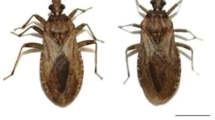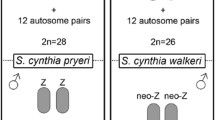Abstract
The reproductive relations and the probability of hybridization between an arrhenotokous and a thelytokous form ofA. mytilaspidis were investigated so as to determine the significance of thelytoky in biosystematic studies and its value as a taxonomic character.
Gene markers were utilized to detect and follow the various phases of the introgressive process between the arrhenotokous and thelytokous forms.
The two forms show only a partiel sexual isolation, the major barrier is prezygotic, arrhenotokous males are much less efficient in recognizing the thelytokous female and copulating with them.
A thelytokous female, once inseminated, will utilize the sperm as efficiently as the arrhenotokous female. Viable and fertile hybrids are produced and when conditions are favorable and a suitable host is present the introgressive process will result in a hybrid swarm. The hybrids acquire traits carried by both ancestral stocks.
Résumé
Les relations reproductrices et la probabilité d'hybridation entre une forme thélytoque et une forme arrhénotoque deAphytis mytilaspidis ont été étudiées afin de définir la signification du mode thélytoque dans les recherches de biosystématique et sa valeur en tant que caractère taxonomique. Des marqueurs génétiques ont été utilisés pour détecter et suivre les différentes phases des processus de transition entre les formes arrhénotoques et thélytoques.
Les deux formes présentent un isolement sexuel partiel, la principale barrière étant prézygotique. Les mâles arrhénotoques sont beaucoup moins efficaces dans la reconnaissance des femelles thélytoques et dans l'accouplement avec celles-ci.
Une femelle thélytoque, une fois inséminée, utilise le sperme aussi bien que la femelle arrhénotoque. Des hybrides viables et fertiles sont produits et lorsque les conditions sont favorables et un hôte convenable disponible il en résulte une descendance hybride qui possède des caractères issus des deux souches ancestrales.
Similar content being viewed by others
Références
Asher, J. H. — 1970. Parthenogenetic and genetic variability II. One locus models for various diploid populations. —Genetics Princeton,66, 369–391.
Brncic, D. — 1954. Heterosis and the integration of the genotype in geographic populations ofD. pseudoobscura. —Genetics Princeton,39, 77–88.
Campbell, R. C. — 1967. Statistics for Biologists. —Cambridge Univ. Press (Paperback), 242 pp.
Clausen, C. P. — 1962. Entomophagous Insects. —Hafner Publ. Co, N. Y., 688 pp.
Compere, H. — 1955. A systematic study of the genusAphytis (Howard) [Hymenoptera: Aphelinidae] with description of new species. —Univ. Calif. Publs. Ent.,10, 271–320.
DeBach, P. — 1960. The importance of taxonomy to biological control as illustrated by cryptic history ofAphytis holoxanthus sp. [Hym: Aphelinidae] a parasite ofChrysomphalus aonidum, andAphytis coheni n. sp. a parasite ofAonidiella aurantii. —Ann. ent. Soc. Am.,53, 701–705.
— — 1969. Uniparental, sibling and semi-species in relation to taxonomy and biological control. —Israel J. Ent.,6, 11–28.
Dobzhansky, T. — 1951. Genetics and the Origin of Species. —Columbia Univ. Press (Paperback 3 rd Ed.), 364 pp.
Dobzhansky, T. — 1970. Genetics of the Evolutionary Process. —Columbia Univ. Press., N. Y. & London, 505 pp.
Dobzhansky, T. &Streisinger, G. — 1944. Experiments on sexual isolation inDrosophila. II. Geographic strains ofDrosophila prosaltans. —Proc. natn. Acad. Sci. U.S.A.,30, 340–345.
Ehrlich, P. R. &Raven, P. H. — 1969. Differentiation of populations. —Science, N. Y.,165, 1228–1232.
Hale, L. J. — 1965. Biological Laboratory Data. —Science Paperbacks and Methusen & Co, London, 146 pp
Levene, H. — 1949. A new measure of sexual isolation. —Evolution, Lancaster Pa.,3, 315–321.
Li, C. C. — 1955. Population Genetics. —Univ. Chicago Press, Chicago & London, 366 pp.
Mayr, E. — 1957 (editor). The Species Problem. —Amer. Assoc. Advanc. Sci. Publ.,50, 395 pp.
Mayr, E. — 1963. Animal Species and Evolution. —Belknap Press, Harvard Univ., 797 pp.
Mayr, E. — 1969. Principles of Systematic Zoology —McGraw Hill Co, 428 pp.
Mayr, E. — 1970. Populations, Species, and Evolution.Belknap Press, Havard Univ., 453 pp.
Rao, S. V. &DeBach, P. — 1969 a. Experimental studies on hybridization and sexual isolation between someAphytis species [Hymenoptera; Aphelinidae] I. Experimental hybridization and an interpretation of evolutionary relationship among the species. —Hilgardia,39, 515–553.
—— — 1969 b. Experimental studies on hybridization and sexual isolation between someAphytis species [Hymenoptera: Aphelinidae] II. Experiments on sexual isolation. —Hilgardia,39, 553–567.
Rieger, R. &Michaelis, A. — 1958. Genetisches und cytogenetisches Wörterbuch. —Springer Verlag, Berlin, 648 pp.
Smith, S. G. — 1955. Cytogenetics of obligatory parthenogenesis. —Can. Ent.,87, 131–135.
Snow, R. — 1963. Alcoholic hydrochloric carmine as a stain for chromosomes in squash preparations. —Stain technol.,38, 9–13.
Sokal, R. R. &Crovello, T. J. — 1970. The biological species concept: A critical evaluation. —Am. Nat.,104, 127–153.
Wallace, B. — 1968. Topics in Population Genetics. —Norton, N. Y., 481 pp.
Wallace, B. &Vetukhiv, M. — 1955. Adaptive organization of the gene-pools ofDrosophila populations. —Cold Spring Harb. Symp. Quant. Biol.,20, 303–310.
Author information
Authors and Affiliations
Additional information
The investigation is a part of a Ph. D. dissertation submitted to the University of California, and was supported by grants Nos. GB 7444 and GB 17829 of the National Science Foundation.
Rights and permissions
About this article
Cite this article
Rössler, Y., DeBach, P. The biosystematic relations between a thelytokous and an arrhenotokous form ofAphytis mytilaspidis (Le Baron) [Hymenoptera: aphelinidae] I. The Reproductive relations. Entomophaga 17, 391–423 (1972). https://doi.org/10.1007/BF02371647
Issue Date:
DOI: https://doi.org/10.1007/BF02371647




